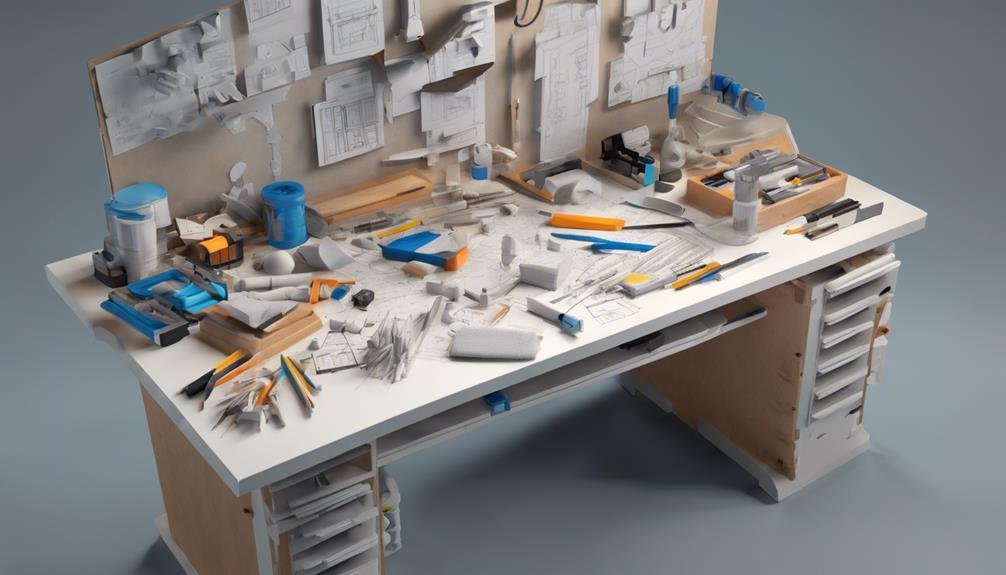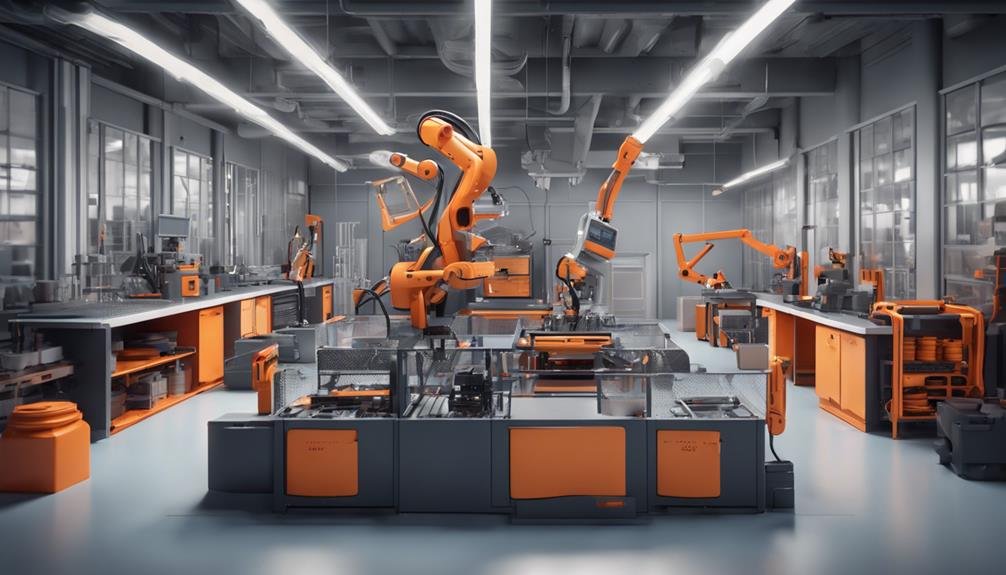You're considering investing in a 3D printer, but wondering if it's worth the cost. The answer lies in the numerous benefits it offers. As a hobbyist or enthusiast, you'll unleash creativity and innovation at home, designing and producing unique projects, and even crafting replacement components. You'll also reduce material waste, implement on-demand manufacturing, and lower setup costs. With rapid prototyping, you can transform ideas into tangible products quickly, and offer unparalleled customization and personalization options. As you delve into the world of 3D printing, you'll realize how it can improve your efficiency and productivity, and much more.
Benefits for Hobbyists and Enthusiasts
With 3D printing, you can access a world of creativity and innovation in the comfort of your own home, where you can design, prototype, and produce unique projects at a fraction of the cost and time of traditional manufacturing methods.
As a hobbyist, you can craft replacement components, unique solutions, and functional parts for personal projects using 3D printers. These printed parts can be really useful in bringing your ideas to life.
Additionally, online communities and resources are available to help you improve your skills in 3D printing. You can share knowledge, collaborate, and learn from others who share similar interests. This access to collective knowledge and expertise enables you to refine your designs, troubleshoot issues, and optimize your printing process.
With 3D printing, you can rapidly produce and iterate on your ideas, accelerating the learning and experimenting process. By leveraging these benefits, you can maximize your full creative potential and take your projects to the next level.
Cost-Effective Production Methods
By adopting 3D printing, you can revolutionize your production process, reducing costs and maximizing efficiency in ways traditional manufacturing methods can't match. This technology offers quite a few things that make it an attractive option for businesses and individuals alike.
Here are just a few ways 3D printing can help you save money and streamline your production:
- Reduced material waste: 3D printing allows you to create objects layer by layer, using only the necessary amount of material, reducing waste and the environmental impact of your production.
- On-demand manufacturing: With 3D printing, you can produce parts and products as needed, eliminating the need for large inventory storage and reducing inventory costs.
- Lower setup costs: 3D printing eliminates the need for expensive tooling and setup costs associated with traditional manufacturing methods, making it a more accessible option for small businesses and hobbyists.
Rapid Prototyping and Design

You can quickly transform your ideas into tangible prototypes with 3D printing, reducing the time and cost associated with traditional prototyping methods. This design flexibility allows you to test and refine your concepts quickly, making iterative improvements with precision control. By producing complex geometries and intricate details with high accuracy, you can unleash creative freedom and bring fresh ideas to life.
With 3D printing, you're no longer limited by the constraints of traditional manufacturing methods, enabling you to think outside the box and push the boundaries of what's achievable.
Furthermore, the ability to design and manufacture in-house reduces lead times, allowing you to make on-the-fly adjustments and modifications as needed. This streamlined process fosters innovation, enabling you to develop new products and solutions swiftly.
Customization and Personalization Options
Tailored to your specific needs, 3D printing offers unparalleled customization and personalization options, allowing you to create one-of-a-kind objects that cater to individual preferences and requirements. With design freedom, you can bring your unique ideas to life, crafting tailored solutions that meet your exact needs. Whether it's a custom phone case, a personalized jewelry piece, or a bespoke tool, 3D printing empowers you to create unique creations that reflect your personality and style.
Some of the benefits of customization and personalization with 3D printing include:
- Creating custom tools and parts that fit your specific requirements
- Designing personalized gifts that hold sentimental value
- Producing bespoke fashion items, such as jewelry or accessories, that reflect your personal style
With 3D printing, you can adapt designs to specific requirements, sizes, colors, and functionalities, giving you the flexibility to bring your ideas to life in a personalized and creative manner. By leveraging the flexibility of 3D printing technology, you can discover new possibilities for customization and personalization, opening up a world of opportunities for unique creations.
Enhanced Efficiency and Productivity

With 3D printing, your workshop's efficiency gets a significant boost as you can create custom tools and adapters on the fly, streamlining your workflow and reducing downtime. You'll experience substantial time savings by producing what you need, when you need it, rather than relying on external suppliers or manufacturers.
This workflow optimization leads to increased output, as you can focus on high-priority tasks while your 3D printer works on creating the necessary components. For instance, you can design and print customized dust collection solutions, such as hose clamps and adapters, to keep your workshop clean and organized.
Additionally, you can develop unique solutions, like spacers and blast gates, tailored to your specific workshop requirements. By being able to design and produce replacement components on-demand, you'll minimize downtime and increase productivity.
With 3D printing, you'll be able to tackle complex projects with ease, making it a valuable asset to your workshop.
Environmental Impact and Sustainability
As you reap the benefits of improved efficiency and productivity in your workshop, it's just as vital to contemplate the environmental implications of 3D printing, which, despite its advantages, contributes to plastic waste and other ecological concerns.
The reality is that 3D printing generates a significant amount of waste, including non-biodegradable plastics and hazardous materials like resin and solvents. Additionally, the variety of materials used in 3D printing makes recycling complex, and improper disposal can exacerbate environmental issues.
To mitigate these concerns, it's important to adopt eco-friendly solutions and sustainable practices.
Consider the following:
- Implement waste management strategies, such as recycling and upcycling, to minimize waste generation.
- Explore sustainable material alternatives, like bioplastics and recyclable materials, for your 3D printing projects.
- Take on environmental responsibility by investing in green innovations, such as energy-efficient printers and eco-friendly printing techniques.
Industry Applications and Opportunities

Across different sectors, you're discovering innovative ways to harness the potential of 3D printing, transforming traditional manufacturing processes and opening up new opportunities.
In the aerospace industry, 3D printing is driving innovations by producing lightweight, complex parts that traditional methods struggle to create. This additive manufacturing technology enables the production of intricate components with increased precision and reduced weight, enhancing performance as a whole.
In the medical field, you're witnessing significant advancements through 3D printing. Personalized implants, prosthetics, and surgical guides are being tailored to individual patients, revolutionizing healthcare.
The automotive industry is also leveraging the benefits of 3D printing, rapid prototyping, and custom tooling, in addition to manufacturing components with reduced weight and improved performance.
Furthermore, architects and jewelers are utilizing 3D printing to create intricate models, detailed prototypes, and even full-scale building components, as well as rapidly producing unique pieces with intricate details.
As you investigate these industry applications, you're realizing the vast potential of 3D printing to transform traditional manufacturing processes and open up new opportunities.
Frequently Asked Questions
What Are 3 Disadvantages of 3D Printing?
You'll face three significant drawbacks with 3D printing: material limitations restrict strength and finish, post-processing requirements add time and effort, and the environmental impact of plastic waste and disposal concerns linger, affecting the entire process.
Is Owning a 3D Printer Expensive?
You'll face an initial investment, but it's the ongoing costs that'll really add up, including maintenance expenses like filament and energy consumption, which can range from $20 to $50 per kilogram, and occasional repair expenses.
Can You Really Make Money With a 3D Printer?
You can turn your 3D printing hobby into a profitable venture by exploring different business models, selling on online marketplaces, and optimizing profit margins to generate a substantial income from your creations.
How Difficult Is It to Use a 3D Printer?
You'll find that using a 3D printer requires mastering a user-friendly interface, understanding different printing techniques, and handling the calibration process, but with practice, you'll overcome the initial learning curve and become proficient.
Conclusion
As you weigh the pros and cons of investing in a 3D printer, consider the benefits that make them worth the investment.
From rapid prototyping and customization options to improved efficiency and sustainability, 3D printing offers a wide range of advantages.
By understanding the cost-effective production methods and industry applications, you'll be well-equipped to harness the full potential of 3D printing and take your projects to the next level.
Contents
- 1 Benefits for Hobbyists and Enthusiasts
- 2 Cost-Effective Production Methods
- 3 Rapid Prototyping and Design
- 4 Customization and Personalization Options
- 5 Enhanced Efficiency and Productivity
- 6 Environmental Impact and Sustainability
- 7 Industry Applications and Opportunities
- 8 Frequently Asked Questions
- 9 Conclusion